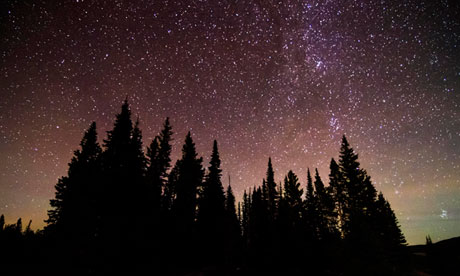
The End of Night takes as its theme the rapid disappearance of darkness in our world or, more accurately, the growing encroachment of light. Night-time as our ancestors knew it, even as recently as the mid-20th century, is under fire. If the lights of the world stage now never quite go out, the question is how does this affect us, its audience, and the other forms of life that share our environment?
The subject is a fertile one – though predictably the answers prove somewhat melancholy – and Bogard sets about his investigations with an energetic purposiveness and enterprise. The bulk of his research involves locations in the United States, but the American landmass is a large and various one, including a wide variety of terrains. In addition, Bogard hops about the globe, to Paris, to Florence, to the Canaries, to the Isle of Sark, like some benign necromancer seeking darkness where he can find it.
By his account, the rapid spread of lighting in our time is a major, and endangering, feature of capitalism. The "brightest beam on Earth" can be found in Las Vegas, emanating from the Luxor casino's blend of nine xenon lights, each 6ft tall and 3ft wide, a veritable deathtrap for the moths and other insects drawn ineluctably by its dazzling allure. But it is a more subtle source of destruction for the bats and night birds that feed from this well-lit buffet, for the feast draws them so far from their natural habitat that the energy expended on the flight to and from the casino leaves them with nothing over to feed and care for their young.
The deleterious effect of dark deprivation upon human creatures is no less significant. One, often moving, section of the book describes the physical and emotional cost of working night shifts. Our circadian rhythms are shot to pieces by exposure to electric light at night, leading to disturbed sleep patterns which in turn breed exhaustion, ragged nerves and a sharp increase in relationship conflicts. There is also compelling evidence that electric light, as opposed to moonlight, starlight or candlelight, has a role to play in cancer – the production of the hormone melatonin, which is a factor in the body's immune system, being suppressed by light – and also in cardiovascular complaints, peptic ulcers, miscarriage and obesity. A further worrying aspect of this inhuman work pattern is that statistically a greater number of night-shift workers are drawn from ethnic populations, thus almost certainly increasing a social deprivation form that they already suffer.
Bogard gamely exposes himself to the dismal conditions of night workers, which brings vividness and a certain authority to his account. In another moving section of the book he meets Ken, a former prisoner, and learns that one enervating effect of prison life is that there is no escape from the constant light that functions as part of the long arm of security. Ken, unsurprisingly, is now a kind of guru of the dark.
The book is in fact structured through a series of meetings with such people who, for better or worse, have something to say about light and darkness – Annie the "witch" from Sark, David Saetre the Wisconsin professor of religion, Donald Griffin the bat man – liberally interspersed with myriad quotations from writers on the subject. One consequence of this is that the book comes to seem a little thin, moving too rapidly from one chatty anecdotal meeting to another, connected by some rather flabby prose. "I'm talking about a night sky that leaves you breathless, that makes you want to study the stars, or write poetry, or dance." I was left with the feeling that this was a book bought on the strength of an exciting proposal but that in the process of writing it some overarching shape got lost.
That is not to say that there are not many good things here – the section on Thoreau's Walden, for example, and the theory that the fear we feel at night is both natural and salutary, prompting in us an increased sense of aliveness by allowing us to face, through darkness, some intimation of our inevitable death. And the conversation with Chris, the astronomer at the US Naval Observatory, offers a few crumbs of hope. According to Chris there exist efficient ways to curb our addiction to light, not by using "better" lighting but by learning where we can afford to abandon it. To seek to let back in a little of the lost starlight and allow more of nature's shadow to reassert its balm seem to me both modest and wholesome aims, and Bogard's book does much to make a case for them.

